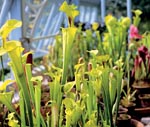New bulbs and exotic plants
Michael finds much to be tempted by at Hampton Court Palace flower show, particularly some hardy plants accustomed to sub-zero temperatures


The bulb catalogues have come, and I thumb my way through them with the zeal of a kleptomaniac. There are the standard orders to be made of hyacinths, Narcissi and tulips they may vary in name and colour, but the same beds need the same quantities, and discretion limits choice of colour. Not that such decisions are easy. Catalogues give flowering times, but they are approximate, as I discovered when the tulips I had chosen to flower in succession from April through mid May merged into each other with uncomfortably clashing colours. Timing, height and colour all have to be carefully planned for the desired effect, and so catalogues without illustrations are a serious disadvantage. But how should one choose the specific varieties on offer? It's simple really. It's your garden. Choose what appeals to you.
We are all human, and the temptation to fill one's greenhouse with pelargoniums and fuchsias with their reliable pro-fusion of colour is ever present. But, diving almost literally in and out of cover at the rain-washed RHS Hampton Court Palace Flower Show, I was tempted by the sight of Gloriosa rothschildiana and the strange bat flower, Tacca chan-trieri (both are tender species for the conservatory or greenhouse), on the stand of bulb specialist Jacques Amand. Many Arisaema come from the high-altitude Himalayas, so hardiness is not a problem for them. I saw a wonderful collection at the Savill Garden recently, and there was a wide range for sale on various stands at Hampton Court. I have had much success with propagating Arisaema sikokianum from our own seed, and now find I have 200 in pots. Patience is essential, as they won't produce flowers until perhaps half a dozen years old. I started planting them out in limited experiments in shady, damp conditions beside a small stream. The emergence of families of young plants around the parent is the signal of success I have been waiting for, and I now want to expand our collection.
I admit that I am easily carried away once I get inside a floral hall. I suppose that is the purpose of them, and, judging by my fellow visitors clutching their plastic bags full of new plants, I am not alone. However, until now I had always managed to stride purposefully past the Sarracenia specialists. Nothing like Sarra-ceniaa race of exotic-looking carnivorous plants could possibly grow in my garden, and, if it did, it would require tender loving care beyond reason, I have always thought. But I have succumbed to their slightly sinister charms. In keeping with the watery world in which we are presently living (allowance must be made for the possibility it has turned to blazing summer when you read this), I was intrigued to learn that a number of Sarracenia will survive winter temperatures well below freezing. These bog plants grow in very wet, acidic conditions in their native North America as far south as Florida. The few I have acquired, including S. flava, are safely ensconced in a cool greenhouse. But they are in for a shock, as I think I will now try them outside.
It is time to think of seeds. I had the exciting experience of walking around our arboretum with fruit and tree scientists Dr Kate Evans and Karen Russell, from East Malling Research. They pointed out to me certain Prunus (cherry blossom) hybrids with near-ripe fruit, on trees that we had bought from Bridgemere Nurseries in 1998. They were a new introduction from Japan, where they had been propagated near the town of Matsumae by the renowned Japanese horticulturist, Mr Asari, and had caught the eye of the late John Bond, a renowned tree expert. Many of the Matsumae Prunus have a wonderful, floriferous quality, but we would not expect them to fruit in this country. Presumably, the fruiting was stimulated by the extraordinary spring weather, and offers a great challenge?unless, that is, the birds get there first. We will give the seeds a little longer to ripen. These, when harvested and cleaned, will need three months or so in the fridge, and who knows what will happen? It is impossible to know the other parent, and the only way to judge the quality of any resulting hybrid is to grow it. Perhaps it's a topic for writing about in 2010!
Exquisite houses, the beauty of Nature, and how to get the most from your life, straight to your inbox.
Country Life is unlike any other magazine: the only glossy weekly on the newsstand and the only magazine that has been guest-edited by His Majesty The King not once, but twice. It is a celebration of modern rural life and all its diverse joys and pleasures — that was first published in Queen Victoria's Diamond Jubilee year. Our eclectic mixture of witty and informative content — from the most up-to-date property news and commentary and a coveted glimpse inside some of the UK's best houses and gardens, to gardening, the arts and interior design, written by experts in their field — still cannot be found in print or online, anywhere else.
-
 You can now rent King William IV’s former home in London’s Mayfair — for a princely sum
You can now rent King William IV’s former home in London’s Mayfair — for a princely sumThe London property — with royal lineage — is on the market with the estate agency Wetherell for £25,000 a week.
-
 Guy Ritchie: 'My mother married an impoverished aristocrat with a knackered country pile. I've been chasing that dream ever since'
Guy Ritchie: 'My mother married an impoverished aristocrat with a knackered country pile. I've been chasing that dream ever since'The film maker opens up about his love for the countryside, and his friendship with Sir David Beckham.
